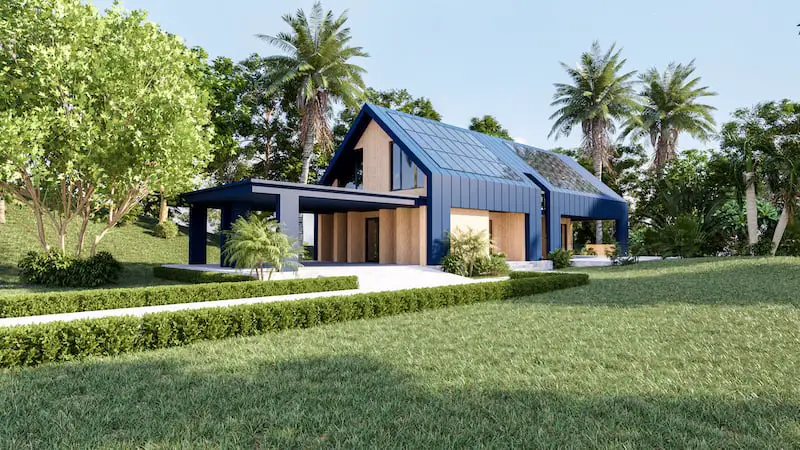A built modular home looks just like a traditional site built home, making the distinction between modular and stick built quite challenging at first sight. Modular homes are prefabricated constructions built per parts or modules, a building process that can offer some limitations.
These limitations are key to help us tell a stick built home apart from a modular home since those key features that can’t be built with modular construction may indicate that the building is instead a stick built house.
- Shape of the building: Round and organically shaped houses are hardly ever built with a modular building process.
- Indoor design: Vast indoor spaces with high ceiling and large open floor plans can’t be designed with strict modular construction due to the structural and transportation requirements of each module.
- Location and access: the construction of modular homes is usually limited to locations accessible through wide roads in good conditions.
- Land topography: Modular homes are often restricted to flat plots of lands, though while complicated topographies are a limitation, it is still possible to build a modular home in such situations.
Contrary to popular belief, modular construction is built up to the same quality and appearance standards as any traditional stick built home. However, the design possibilities vary from one to the other due to their construction process.
The fact that a modular home is prefabricated tends to carry misconceptions.
Prefabricated means built off-site, though there are different kinds of prefabricated houses. Often modular homes are confused with another prefabricated type of house: the manufactured or mobile home.
All manufactured homes share a similar look and can easily be told apart from stick built homes. This however, is not the case with modular construction, which looks just like a stick built home.
Some of the main reasons why modular homes, don’t all look alike and instead resemble traditional construction are:
- No design limitations. While transportation is required because the house is built off-site, it is built per modules and the overall size and shape of the house won’t be determined by the transportation truck size. The size of the truck will only affect the dimensions of each one of the modules, though once assembled on site the overall size and shape of the house will be determined by the combination of those.
- Permanent foundations. Modular homes are placed on permanent foundations and once all the modules are assembled and permanently placed over the foundations there will be no visible signs of the fact that those modules have been transported. The connection of the house to the land is just like that one of a stick built home.
- Variety of materials and finishes. Modular homes can be built with a variety of materials including concrete, steel and wood. The same kind of materials used for stick built houses can be used to build modular homes, making it difficult to distinguish between these two types.
- Same building restrictions. Despite its construction technique, a modular home is required to follow the same building codes and regulations as any stick built home built in the same area. Therefore, every modular home will be subject to the design or safety regulations defined by the state and local codes from the place where they will be built instead of a generalized code applicable to modular construction.
Limitation of modular construction that don’t affect stick built homes
Shape of the building
Modular homes are entirely build in a factory-like environment and the only structural element built on site are the foundations. Therefore, every module will be conceived as a structural unit by itself that once assembled with the other modules, together will conform the overall structure of the house [1].
The reason behind this structural system is simple: when transported each module requires a structure to keep it from breaking due to the vibration and movement caused by the track. Moreover, since every module is already stabilized individually there is no need for a separated structure for the overall house, saving time and money. Therefore, the structure of a modular home is a result of the structure of each module.
This construction technique and transportation requirements makes it very difficult for modular homes to be designed as a round or organically shape house. And until the date, no modular home manufacturer has succeeded with a round home design.
Even if a manufacturer would come across a suitable design, it wouldn’t allow much customization of size and distribution due to the structural requirement of the overall house. Also a round modular home might not be able to offer the benefits of a round design such as an open floor plan design centred under the dome shaped roof.
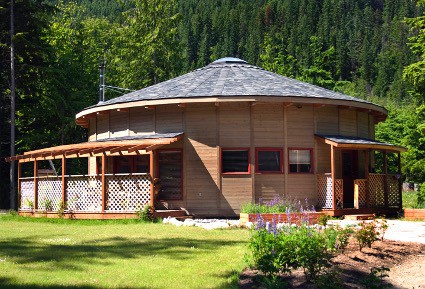
Figure 1
Therefore, if to this date we spot an already built circular home, we can pretty much be sure that it is not a modular home. It will though be difficult to tell if it is a stick built or a prefabricated construction, since prefabricated companies have been very successful with these kind of designs.
Interior design
While modular construction can be combined with other construction techniques and obtain a house that mixes different types of construction, a home build purely modular will present some interior design limitations.
The limitations associated to this system are directly related to the limitations of module size, transportation limitations and its structural needs. Considering that every module will measure approximately 12 to 15,9 feet wide, 60 to 72 feet long and 11 feet high [2]; it will be difficult to design a modular home with remarkably high ceilings and bigger open floor plan spaces.
While it is possible to design open floorplan houses, those are of limited sizes and structure. An only ground floor house with a ceiling higher than 8 feet tall will most likely be a stick built home since due to transportation regulations, a module can’t be built higher than that [3].
However, if the house has additional floors, it could count with higher ceilings. Still, in this case the open floor plan under the high ceiling can’t be too big and will usually be restricted to the maximum module size; being 12 to 15,9 feet wide and 60 to 72 feet long [2].
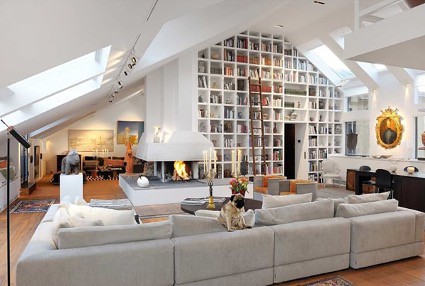
Therefore, if a house has vast indoor open spaces with high ceilings and large open floor plans, it will rarely be a modular home and either combine modular with other construction techniques or be a stick built or prefabricated structure.
Location and access
The fact that a modular house is built off-site ensures that the construction process won’t be affected by the weather conditions associated to that location. However, modular construction can’t be built anywhere.
Since every module conforming the house is finished in the factory and transported to the site, it is imperative for the full-size track to be able to reach the plot where the house will be constructed. Therefore, a modular home will usually only be built on locations with wide roads in good conditions and without obstacles such as tunnels, narrow bridges, trees or steep hills [4].
If the only access to the house is through roads in bad conditions that are very steep, narrow and/or with tight curves; that house will most likely be stick built or built on-site since it would have been difficult for the full-size truck to have delivered the modules to the site.
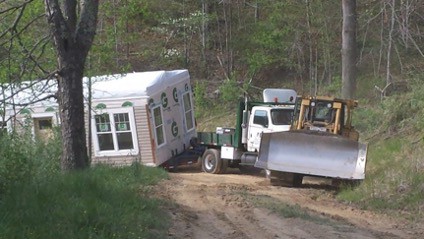
Land topography
Modular homes are in most cases designed and built to be placed on flat lands. Some modular home manufacturers will accept the challenge to build in slopped topography, though keep in mind that inclination will require excavation, specialized foundations or customized designs like a split-level home; all of which will add difficulty and cost to the project [5].
However, it will be difficult to be sure that a house hasn’t been built per modules just because the land topography is rough. Since even though the design will be challenging and the cost will definitely become higher, some modular home builders who allow full design customization can still built beautiful modular homes in such locations.
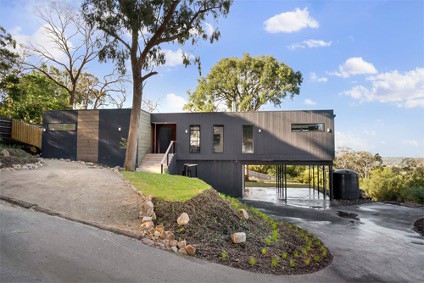
Signs to distinguish a stick built home from a modular home once built
While it will be very difficult to pinpoint an already built house as a modular construction and clearly distinguish it from a stick built home, understanding the limitations of modular construction is key to identify those features that would very rarely show in a modular house.
Some of these non-modular features are:
- Round house
- Organic unique shapes
- Vast indoor open spaces
- Remote location with difficult access
All these features are in most cases separated from modular homes, and can perfectly be encompassed by a stick built house. However, while we can confirm that a house with these characteristics it is not a modular home, we cannot confirm it is stick built since other types of construction such as prefabricated houses or mixed constructions could perfectly be built with these characteristics.
References:
- Wilson, J. Design for Modular Construction: An introduction for Architects Building Green, Inc.https://content.aia.org/sites/default/files/2019-03/Materials_Practice_Guide_Modular_Construction.pdf
- Gianino, A. Modular Size: Maximum Length, width, and Height The Home Store https://www.the-homestore.com/blog/2013/03/modular-size/
- Custom Design Modular Home Design Limitation Modular Home Place https://www.modularhomeplace.com/modular-home-design-limitations.html
- Semler, K. How can you get a modular home to my site Impresa Modular https://impresamodular.com/how-can-you-get-modular-home-to-site/
- (2018, August 21) How to Purchase land for a modular home MODSCAPE.https://www.modscape.com.au/blog/3-factors-consider-purchasing-land-future-modular-home/
Fig. 1. Ross, R. (2017, April 4) Why our ancestors built round houses – and why it still makes sense to build round structures today Inhabitat® https://inhabitat.com/why-our-ancestors-built-round-houses-and-why-it-still-makes-sense-to-build-round-structures-today/evans_17/
Fig. 2. Open Plan Loft with Amazingly High Ceilings Trendir https://www.trendir.com/open-plan-loft-with-amazingly-high-ceilings/
Fig. 3. Semler, K. How can you get a modular home to my site Impresa modular https://impresamodular.com/how-can-you-get-modular-home-to-site/Fig. 4. Raikes L. (2017, Jun 16) Cam I build a Modular Home on a Sloping Block? Anchor Homes https://blog.anchorhomes.com.au/build-modular-home-on-sloping-block
